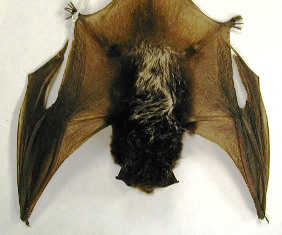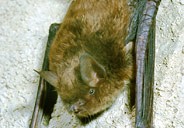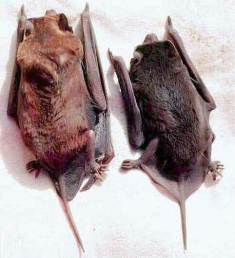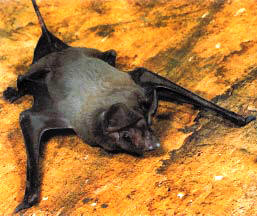Discover Florida Nature
It's time to explore the natural Florida


|
|
|
|
|
Bats are mammals. They account for more than 25 percent of all the
mammals on the earth! Bats are the only mammals that can fly. There are
good reasons to appreciate bats in Florida. One of the wonderful things
that most bats do is eat insects! By eating their body weight in
insects each night, bats are the most important controller of
night-flying insects, including many crop pests. Some bats eat fruit,
nectar and seeds from plants. When the bats spit out the seeds or leave
them in their droppings, they help new plants to grow. They also
pollinate many kinds of plants, including vanilla beans, peaches,
bananas and avocados. Silver-haired
Bat-
The silvered-haired bat is a medium-size bat. It's dark brown-black
hairs are tipped with silver giving it an icy appearance. The
silver-tipped hairs do not extend to the face or neck. Their ears are
short, rounded and without fur. The silver-haired bats are migratory,
and sometimes migrate in groups. There are several records of groups of
weary bats descending upon ships at sea. Some bats netted during summer
months and banded were recaptured over 100 miles away! A typical day
roost for the silver-haired bat is the space behind a piece of loose
bark on a tree. Individuals have also been found in
woodpecker holes and on bird's nests. During migration they may be
encountered in a wide variety of other shelters. Although they may
appear in any kind of building, they favor open sheds, garages, and
outbuildings rather than enclosed attics. They frequently rest in a pile
of slabs, lumber, railroad ties, or fence posts, especially when
migrating through the prairies where shelters are scarce. Silver-haired
Bat-
The silvered-haired bat is a medium-size bat. It's dark brown-black
hairs are tipped with silver giving it an icy appearance. The
silver-tipped hairs do not extend to the face or neck. Their ears are
short, rounded and without fur. The silver-haired bats are migratory,
and sometimes migrate in groups. There are several records of groups of
weary bats descending upon ships at sea. Some bats netted during summer
months and banded were recaptured over 100 miles away! A typical day
roost for the silver-haired bat is the space behind a piece of loose
bark on a tree. Individuals have also been found in
woodpecker holes and on bird's nests. During migration they may be
encountered in a wide variety of other shelters. Although they may
appear in any kind of building, they favor open sheds, garages, and
outbuildings rather than enclosed attics. They frequently rest in a pile
of slabs, lumber, railroad ties, or fence posts, especially when
migrating through the prairies where shelters are scarce.  Southeastern
Myotis-
The southeastern myotis is usually found in the
northern half of the state of Florida and tends to live near streams,
ponds and reservoirs. The southeastern myotis is predominantly a cave
bat in that part of its range where suitable caves occur. Outside of
caves, it has been found in crevices between bridge timbers; culverts
and drain pipes, boat houses, barns, and the attics of houses; and in
hollow trees. The bats are usually closely associated with water and
when they leave their diurnal roosts around dark, they fly to nearby
ponds and streams over which they forage and from which they drink,
usually flying within 2 feet of the surface of water to catch insects.
Most often, maternity colonies are located above water within caves.
Even though this species is listed as a species of special concern,
Florida has the highest concentration of these bats and their maternity
caves in the world. Southeastern
Myotis-
The southeastern myotis is usually found in the
northern half of the state of Florida and tends to live near streams,
ponds and reservoirs. The southeastern myotis is predominantly a cave
bat in that part of its range where suitable caves occur. Outside of
caves, it has been found in crevices between bridge timbers; culverts
and drain pipes, boat houses, barns, and the attics of houses; and in
hollow trees. The bats are usually closely associated with water and
when they leave their diurnal roosts around dark, they fly to nearby
ponds and streams over which they forage and from which they drink,
usually flying within 2 feet of the surface of water to catch insects.
Most often, maternity colonies are located above water within caves.
Even though this species is listed as a species of special concern,
Florida has the highest concentration of these bats and their maternity
caves in the world.  Velvety
Free-tailed Bat-The velvety free-tailed bat was first
discovered in the Florida Keys in 1994. It is believed this species
arrived in Florida from Cuba as a result of natural causes. Since then
it has expanded its range throughout most of the Florida Keys from Key
West to Key Largo. The velvety free-tailed bat is a medium sized bat,
weighing just 0.5 ounces (15 grams), with a forearm measuring 2 1/3 to 2
5/8 inches (59 to 61 millimeters), and high aspect ratio wings that are
very long and narrow, facilitating fast and efficient flight. Their long
and narrow wings require them to gain speed before flight to attain
lift; they must drop vertically from their perch before they extend
their wings. The short velvety fur varies in color from dark brown to
dark gray. Like other bats in the family Molossidae the tail extends
well beyond a short tail membrane. So far, in Florida, the velvety
free-tailed bat has only been found roosting in buildings. In Cuba they
are known to roost in rock crevices, tree hollows, buildings and the
cracks in utility poles. Velvety free-tailed bats feed on planthoppers,
leafhoppers, grasshoppers, moths, beetles,
mayflies and other small
flying insects. Females give birth to a
single pup, but may have more than one reproductive cycle in a year.
Pups are born during the summer from June through September. Velvety
Free-tailed Bat-The velvety free-tailed bat was first
discovered in the Florida Keys in 1994. It is believed this species
arrived in Florida from Cuba as a result of natural causes. Since then
it has expanded its range throughout most of the Florida Keys from Key
West to Key Largo. The velvety free-tailed bat is a medium sized bat,
weighing just 0.5 ounces (15 grams), with a forearm measuring 2 1/3 to 2
5/8 inches (59 to 61 millimeters), and high aspect ratio wings that are
very long and narrow, facilitating fast and efficient flight. Their long
and narrow wings require them to gain speed before flight to attain
lift; they must drop vertically from their perch before they extend
their wings. The short velvety fur varies in color from dark brown to
dark gray. Like other bats in the family Molossidae the tail extends
well beyond a short tail membrane. So far, in Florida, the velvety
free-tailed bat has only been found roosting in buildings. In Cuba they
are known to roost in rock crevices, tree hollows, buildings and the
cracks in utility poles. Velvety free-tailed bats feed on planthoppers,
leafhoppers, grasshoppers, moths, beetles,
mayflies and other small
flying insects. Females give birth to a
single pup, but may have more than one reproductive cycle in a year.
Pups are born during the summer from June through September. Wagner's
Bonneted Bat-
The Wagner's mastiff bat is Florida's largest bat and is found in
southern Florida. Its fur ranges in color from dark gray to
brownish-gray. As with other bats in the family Molossidae its tail
extends well beyond a short tail membrane. It has large broad ears that
slant forward over the eyes from which it gets the common name of
"bonneted bat."These bats have a loud, piercing call that is easily
picked up by human ears. The roosting preferences for these bats are
barrel-tile roofs, tree hollows, and holes and shafts of royal
palm trees. They emerge to forage much later than most bats, leaving
well after dark. Wagner's bonneted bats seldom forage lower than 30
feet. These bats can take flight from horizontal surfaces, a feat most
of our bats can't do easily. . Females give birth to a single pup, but
may have more than one reproductive cycle per year. Pups are born
during the summer from June through September. Wagner's
Bonneted Bat-
The Wagner's mastiff bat is Florida's largest bat and is found in
southern Florida. Its fur ranges in color from dark gray to
brownish-gray. As with other bats in the family Molossidae its tail
extends well beyond a short tail membrane. It has large broad ears that
slant forward over the eyes from which it gets the common name of
"bonneted bat."These bats have a loud, piercing call that is easily
picked up by human ears. The roosting preferences for these bats are
barrel-tile roofs, tree hollows, and holes and shafts of royal
palm trees. They emerge to forage much later than most bats, leaving
well after dark. Wagner's bonneted bats seldom forage lower than 30
feet. These bats can take flight from horizontal surfaces, a feat most
of our bats can't do easily. . Females give birth to a single pup, but
may have more than one reproductive cycle per year. Pups are born
during the summer from June through September.
|
|
|
Advertise | Privacy Statement | Contact | Alaska Nature | Michael Arnold Art| Dog Encyclopedia | Dog Encyclopedia| |
|